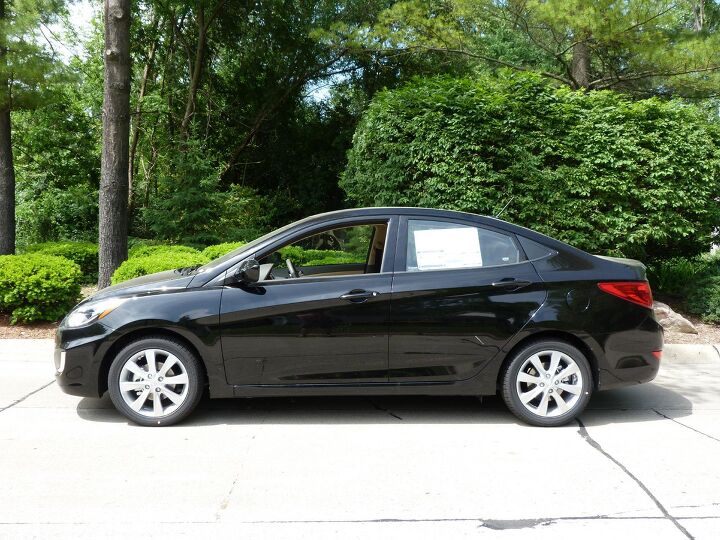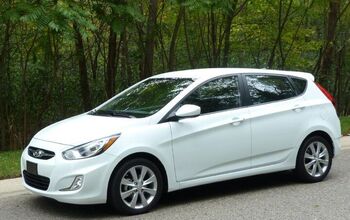Review: 2012 Hyundai Accent GLS Sedan
The Hyundai Accent has never been a “gotta have it” sort of car. Instead, it’s been a “what’s the cheapest thing you got?” sort of car. The 2011 started at just $9,985 (plus shipping and handling). That’s “started,” as in past tense, because the 2011 is history. The 2012, now arriving at dealers, starts at $12,445 plus $760 for destination. Add an automatic transmission, A/C, the $1,300 Premium Package (fog lights, cruise, remote keyless, Bluetooth, upgraded interior trim, 16” alloy wheels in place of 14” steelies), and floor mats, and you’re looking at a $17,350 sticker. Clearly Hyundai thinks they’ve developed a much more desirable car. Have they?
Hyundai couldn’t get a new Accent to me before an upcoming vacation, and reviews based on press cars are embargoed until June 22nd regardless, so in the interest of reporting on the car early I dropped by the dealer. At first they didn’t appear to have a 2012 Accent. Then I noticed that the fog lights on one of the Elantras wasn’t quite like the others—because it wasn’t an Elantra. From the front the cars aren’t easy to tell apart. From the side, the Accent sedan has the same highly styled shape as the Elantra, with swept back headlights, a strong character line rising through the door handles, and an arching roofline that terminates over yet another, even larger black plastic triangle. But this shape is compressed into a 172-inch length, a half-foot less than the Elantra. So, like the previous-generation Elantra, the new Accent sedan appears thick through the midsection. As with the Ford Fiesta, the new hatchback (which isn’t yet at dealers) is considerably more attractive.
Inside the new Accent, Hyundai’s designers weren’t permitted to indulge themselves as much as they were with the Elantra. So there are no wavy curves, just a clean, straightforward design with easy-to-use controls—including three separate knobs for the HVAC. The surfaces are primarily hard plastic, but they are attractively textured and feel solid. The Premium Package’s piano black trim adds an upscale touch; the silver trim that remains on the doors, not so much. Some piano black would be welcome there as well. This being a GLS sedan with the Premium Package, the tan cloth aspires to look and feel luxurious. I’d personally prefer a heftier, sportier fabric, but perhaps such is fitted to the SE hatchback. In terms of materials, you might be able to do a little better in this segment; you can certainly do much worse.
There are benefits to the Accent’s stubbier length: the windshield couldn’t be laid back so far, so the instrument panel isn’t as deep and the driving position is much better than that in the Elantra. The forward view is very open, inspiring confidence. Unfortunately, the manual tilt front seat adjustment standard in past Accents is gone, as it is from most cars these days. The steering wheel tilts, but does not telescope.
The Accent’s front seats are comfortably shaped, moderately firm, and provide a decent amount of lateral support. Those of you who always ask if a tall person can fit (you know who you are) might actually be able to fit—the driver’s seat has quite a bit of travel. When the front seat is positioned for the average adult male, there’s easily enough room in the back seat for another such male—and so far more than in the Mazda2 or the Fiesta. The Elantra offers a couple inches more legroom than the new Accent, but its rear seat is positioned lower (and even then doesn’t have allow quite as much headroom), so I actually find the Accent’s rear seat more comfortable. Trunk volume of 13.7 cubic feet is just a single cube shy of the Elantra, and quite good for such a small car.
The Accent GLS automatic weighs in at 2,463 pounds, so about 100 pounds heavier than a Mazda2 or Toyota Yaris but nearly 200 lighter than a Chevrolet Sonic or Ford Fiesta and nearly 300 lighter than the larger Elantra. Despite this relatively low weight, the car feels more solid than most in the class and even the Elantra. Factor in a direct-injected 1.6-liter engine that, with 138 peak horsepower, checks in only ten short of the conventionally injected 1.8 in the Elantra (and well above any others in the segment—the Fiesta’s 120 is next best), and even with the six-speed automatic the Accent never feels slow. With the manual transmission it might even feel quick. Even a strong 1.6 in a relatively light car must work fairly hard, so it’s a good thing that this engine likes to rev and sounds good (if not quiet) while doing so. The transmission can be manually shifted, but generally selects the appropriate gear when left to itself and lets the engine do what it needs to do, with shifts in the low 3000s in casual driving. In normal mode (there’s also an “Eco” mode) the transmission doesn’t lug the engine the ways it sometimes does in the Elantra, Sonata, and Tuscon.
Perhaps because the transmission isn’t tuned to be a killjoy, the EPA ratings are nearly identical to those of the heavier, port-injected Elantra, 30/40 instead of 29/40. Not quite the cause for celebration such numbers would have been just a year ago, but who’s doing to complain about “just” 30/40? Especially when the car is much roomier than competitors who fare no better (and who often fare worse) on the EPA’s rollers.
So here’s the part where I tell you that the car functions well, but isn’t any fun to drive. Except it actually is. The aforementioned driving position certainly contributes. The electric motor-assisted steering does feel artificial, even a bit gummy on center, but does have a satisfying firmness and loads up progressively when turned. Understeer and body lean are minimal, and the chassis remains composed and thoroughly predictable up to the limits of the front tires. The suspension is tuned much better than that in the Elantra (whose ride continually irritated me). Thanks to firmer damping, body motions are better controlled over uneven road surfaces. Some people might find the ride a little too firm, but for anyone who cares about driving it’s about as good as it gets with a 101-inch wheelbase. A Ford Fiesta does feel cushier, but also feels soggier when exercised. A Mazda2 feels lighter and more agile, and so is more fun to drive on a twisty road, but also looks and feels much cheaper. As in the Ford, wind and road noise are surprisingly low even at highway speeds—unlike the subcompacts of years past, the Accent is a car that could comfortably be driven for long distances.
I haven’t yet input pricing for the 2012 Accent into TrueDelta’s car price comparison tool–but should before the end of the month. For now, a less precise comparison will have to do. You cannot load up an Accent the way you can a Ford Fiesta. Features like leather upholstery, seat heaters, sunroof, and keyless ignition simply aren’t available. A leather-wrapped steering wheel can only be found in the Accent SE hatchback (MSRP with automatic: $17,555). So the midlevel Fiesta SE sedan seems to match up most closely with the $17,350 car I drove. Similarly equipped, one lists for $17,060, so a few hundred dollars less. Similarly outfit a Nissan Versa and a Toyota Yaris, and they list for $18,180 and $18,630, respectively, well above the Ford and Hyundai. So while the Accent certainly isn’t in the bargain basement, it continues to check in at the low end of the segment’s price range. A similarly-equipped Hyundai Elantra: $18,445, just over $1,000 more than the Accent.
The 2012 Hyundai Accent has a surprising number of strengths, including the best combination of power, fuel economy, handling, ride, room, driving position, interior materials, and overall refinement you’ll find in the segment. Some competitors are ahead in one or two of these areas, but not by much, and then lag severely in others. In hatchback form the new Accent is even attractive (and the sedan isn’t bad looking). This combination of attributes is so compelling that it’s not only easy to see why many people will desire the Accent more than other B-segment cars. Many will also find that it’s a better car than the Hyundai Elantra. The only significant advantage of the larger, more expensive car: you can get it with heated leather seats, sunroof, and nav. Don’t want these? Then the better-driving Accent is the way to go—even if you can’t get one for anywhere near ten grand anymore.
Glassman Hyundai in Southfield, MI, generously provided the car. They can be reached at 248-354-3300.
Michael Karesh operates TrueDelta, an online source of automotive pricing and reliability data.
Michael Karesh lives in West Bloomfield, Michigan, with his wife and three children. In 2003 he received a Ph.D. from the University of Chicago. While in Chicago he worked at the National Opinion Research Center, a leader in the field of survey research. For his doctoral thesis, he spent a year-and-a-half inside an automaker studying how and how well it understood consumers when developing new products. While pursuing the degree he taught consumer behavior and product development at Oakland University. Since 1999, he has contributed auto reviews to Epinions, where he is currently one of two people in charge of the autos section. Since earning the degree he has continued to care for his children (school, gymnastics, tae-kwan-do...) and write reviews for Epinions and, more recently, The Truth About Cars while developing TrueDelta, a vehicle reliability and price comparison site.
More by Michael Karesh
Latest Car Reviews
Read moreLatest Product Reviews
Read moreRecent Comments
- Corey Lewis It's not competitive against others in the class, as my review discussed. https://www.thetruthaboutcars.com/cars/chevrolet/rental-review-the-2023-chevrolet-malibu-last-domestic-midsize-standing-44502760
- Turbo Is Black Magic My wife had one of these back in 06, did a ton of work to it… supercharger, full exhaust, full suspension.. it was a blast to drive even though it was still hilariously slow. Great for drive in nights, open the hatch fold the seats flat and just relax.Also this thing is a great example of how far we have come in crash safety even since just 2005… go look at these old crash tests now and I cringe at what a modern electric tank would do to this thing.
- MaintenanceCosts Whenever the topic of the xB comes up…Me: "The style is fun. The combination of the box shape and the aggressive detailing is very JDM."Wife: "Those are ghetto."Me: "They're smaller than a Corolla outside and have the space of a RAV4 inside."Wife: "Those are ghetto."Me: "They're kind of fun to drive with a stick."Wife: "Those are ghetto."It's one of a few cars (including its fellow box, the Ford Flex) on which we will just never see eye to eye.
- Oberkanone The alternative is a more expensive SUV. Yes, it will be missed.
- Ajla I did like this one.

















































Comments
Join the conversation
As an 2003 Accent GS owner, I'd totally get this car in about five years -- used. Our current Accent has around 146,000 miles with the original clutch, cold air. It's been a beater and a half: scuffed up on the outside but still running strong. And just got a 2007 Sonata 5-speed M/T...I must be boring 'cause I really like the way the car looks and drives. Reliability is sexy to me. And if I want to haul ass, I jump on the Honda Blackbird on nice days to hit 100+plus in under 7 seconds. But I really do like the sedan...it does look like a Civic ripoff but I don't care.
I recently bought the 2012 accent gls base model. It has 138 hp I was thinking about doing a couple mods to it any suggestions? Thanks in advanced!